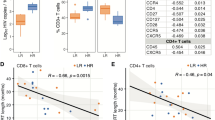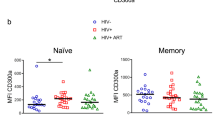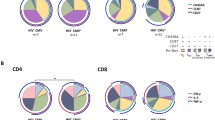Abstract
Using fresh whole blood or isolated lymphocytes, the activity ofin vivo generated cytotoxic T-lymphocytes (CTL) was measured as the OKT3-specific lysis of HL-60 targets, in a cross-sectional study of 53 HIV(+) patients. CTL activity in the entire HIV(+) group was two to three times higher than in HIV(−) controls, with WHO stage 3 (=pre-AIDS) patients showing the highest cytolytic function. The whole-blood CTL assay was validated and its practical and theoretical advantages are discussed. Within the CD8(+) cells, the number and proportion of the CD45RO(+) “memory” subset were significantly increased in HIV(+) subjects. The HLA-DR(+) subset rose most spectacularly in the asymptomatic stage of the infection, while the CD38(+) subset was the only one still significantly rising between the pre-AIDS and the AIDS stage. CTL activity was most closely correlated with T8 cells expressing the CD38 marker. In the context of CTL, CD38 thus seems to reflect activation rather than immaturity. Lymphocytes from HIV(+) subjects with a high OKT3-specific lytic capacity also destroyed normal lymphoblasts to a significant extent, pointing to their possible involvement in an autodestructive process. Our data thus suggest the importance of T8 cytolytic function and/or T8 subtyping in the immunopathogenesis and the prognosis of HIV infection.
Similar content being viewed by others
References
Borysiewicz LK, Sissons JGP: Immune response to virus-infected cells.In Clinics in Immunology and Allergy, Britten V, Hughes HPA (eds). London, W. B. Saunders, 1986, pp 159–188
Walker BD, Plata F: Cytotoxic lymphocytes-T against HIV. AIDS 4:177–184, 1990
Hoffenbach A, Langlade-Demoyen P, Dadaglio G, Vilmer E, Michel F, Mayaud C, Autran B, Plata F: Unusually high frequences of HIV-specific cytotoxic T lymphocytes in humans. J Immunol 142:452–462, 1989
Hoffman RW, Bluestone JA, Leo O, Shaw S: Lysis of anti-T3-bearing murine hybridoma cells by human allospecific cytotoxic T cell clones and inhibition of that lysis by anti-T3 and anti-LFA-1 antibodies. J Immunol 135:5–8, 1985
Phillips JH, Lanier LL: Lectin-dependent and anti-CD3 induced cytotoxicity are preferentially mediated by peripheral blood cytotoxic T lymphocytes expressing leu-7 antigen. J Immunol 136:1579–1585, 1986
Leeuwenberg JFM, Spits H, Tax WJM, Capel PJA: Induction of nonspecific cytotoxicity by monoclonal anti-T3 antibodies. J Immunol 134:3770–3774, 1985
Itoh K, Balch CM, Platsoucas CD: Spontaneous human T-cell cytotoxicity against murine hybridomas expressing the OKT3 monoclonal antibody: Comparison with natural killer cell activity. Cell Immunol 108:313–322, 1987
Ito M, Usuba O, Unkeless JC, Schreiber R, Celada F, Bona CA, Moran TM: Sideways killing—The cytolysis of Fc-receptor-bearing cells through bridging to cytolytic lymphocytes-T by antibodies specific for the T-Cell receptor-T3 complex. Scand J Immunol 29:659–669, 1989
Shanahan F, Leman B, Deem R, Niederlehner A, Brogan M, Targan S: Enhanced peripheral blood T-cell cytotoxicity in inflammatory bowel disease. J Clin Immunol 9:55–64, 1989
Vanham G, Kestens L, Gigase P, Colebunders R, Vandenbruaene M, Brijs L, Ceuppens JL: Evidence for circulating activated cytotoxic T cells in HIV-infected subjects before the onset of opportunistic infections. Clin Exp Immunol 82:3–9, 1990
De Paoli P, Villalta D, Battistin S, Gasparollo A, Santini G: Selective loss of OKT8 lymphocytes on density gradient centrifugation separation of blood mononuclear cells. J Immunol Methods 61:259–260, 1983
Renzi P, Ginns LC: Analysis of T cell subsets in normal adults. Comparison of whole blood lysis technique to Ficoll-Hypaque separation by flow cytometry. J Immunol Methods 98:53–56, 1987
Janossy G, Tidman N, Papageorgiou ES, Kung PC, Goldstein G: Distribution of T lymphocyte subsets in the human bone marrow and thymus: An analysis with monoclonal antibodies. J Immunol 126:1608–1613, 1981
Fitchen JH, Foon KA, Cline MJ: The antigenic characteristics of hematopoietic stem cells. N Engl J Med 305:17–25, 1981
Hercend T, Rits J, Schlossman SF, Reinherz EL: Comparative expression of T9, T10, and Ia antigens on activated human T cell subsets. Hum Immunol 3:247–259, 1981
Reinherz EL, Kung PC, Goldstein G, Levey RH, Schlossman SF: Discrete stages of human intrathymic differentiation: Analysis of normal thymocytes and leukemic lymphoblasts of T-cell lineage. Proc Natl Acad Sci USA 77:1588–1592, 1980
Merkenschlager M, Beverley PCL: Evidence for differential expression of CD45 isoforms by precursors for memory-dependent and independent cytotoxic responses: Human CD8 memory CTLp selectively express CD45RO (UCHL1). Int Immunol 1:449–459, 1989
Takeuchi T, DiMaggio M, Levine H, Schlossman SF, Morimoto C: CD11 molecule defines two types of suppressor cells within the T8+ population. Cell Immunol 111:398–409, 1988
Salazar-Gonzalez JF, Moody DW, Giorgi JV, Martinez-Maza O, Mitsuyasu RT, Fahey JL: Reduced ecto-5′-nucleotidase activity and enhanced OKT10 and HLA-DR expression on CD8 (Tsuppressor/cytotoxic) lymphocytes in the acquired immune deficiency syndrome: Evidence of CD8 cell immaturity. J Immunol 135:1778–1785, 1985
Lewis DE, Puck JM, Babcock GF, Rich RR: Disproportionate expansion of a minor T cell subset in patients with lymphadenopathy syndrome and acquired immunodeficiency syndrome. J Infect Dis 151:555–559, 1985
Stites DP, Casavant CH, McHugh TM, Moss AR, Beal SL, Ziegler JL, Saunders AM, Warner NL: Flow cytometric analysis of lymphocyte phenotypes in AIDS using monoclonal antibodies and simultaneous dual immunofluorescence. Clin Immunol Immunopathol 38:161–177, 1986
Prince HE, Arens L, Kleinman SH: CD4 and CD8 subsets defined by dual-color cytofluorometry which distinguish symptomatic from asymptomatic blood donors seropositive for human immunodeficiency virus. Diagn Clin Immunol 5:188–193, 1987
Ziegler-Heitbrock HW, Stachel D, Schlunk T, Gurtler L, Schramm W, Froschl M, Bogner JF, Riethmuller G: Class-II (DR) antigen expression on CD8+ lymphocyte subsets in acquired immune deficiency syndrome (AIDS). J Clin Immunol 8:473–478, 1988
Giorgi JV, Detels R: T-Cell Subset alterations in HIV-infected homosexual men—Niaid Multicenter AIDS cohort study. Clin Immunol Immunopathol 52:10–18, 1989
Stites DP, Moss AR, Bacchetti P, Osmond D, Mchugh TM, Wang YJ, Hebert S, Colfer B: Lymphocyte subset analysis to predict progression to AIDS in a cohort of homosexual men in San Francisco. Clin Immunol Immunopathol 52:96–103, 1989
Schnizlein-Bick CT, Magier MR, Jones RB, Fife KH, Katz BP, Walker EB: Differences among mononuclear cell subpopulations in HIV seropositive or seronegative homosexual and heterosexual men as determined by four-colour flow cytometry. J Acq Immune Def Syndr 3:747–755, 1990
Zarling JM, Ledbetter JA, Sias J, Fultz P, Eichberg J, Gjerset G, Moran PA: HIV-Infected humans, but not chimpanzees, have circulating cytotoxic lymphocytes-T that lyse uninfected Cd4+ cells. J Immunol 144:2992–2998, 1990
Israel-Biet D, Venet A, Beldjord K, Andrieu JM, Even P: Autoreactive cytotoxicity in HIV-infected individuals. Clin Exp Immunol 81:18–24, 1990
Ritz J, Schmidt R, Michon J, Hercend T, Schlossman SF: Characterization of functional surface structures on human natural killer cells. Adv Immunol 42:181–211, 1989
Nitta T, Yagita H, Sato K, Okumura K: Involvement of Cd56 (Nkh-1/Leu-19 Antigen) as an adhesion molecule in natural killer-target cell interaction. J Exp Med 170:1757–1761, 1989
Nagler A, Lanier LL, Cwirla S, Phillips JH: Comparative studies of human FcRIII-positive and negative natural killer cells. J Immunol 143:3183–3191, 1989
Srour EF, Leemhuis T, Jenski L, Redmond R, Jansen J: Cytolytic activity of human natural killer cell subpopulations isolated by 4-color immunofluorescence flow cytometric cell sorting. Cytometry 11:442–446, 1990
Plaeger-Marshall S, Spina CA, Giorgi JV, Mitsuyasu R, Wolfe P, Gottlieb M, Beall G: Alterations in cytotoxic and phenotypic subsets of natural killer cells in acquired immune deficiency syndrome (AIDS). J Clin Immunol 7:16–23, 1987
WHO: Acquired immunodeficiency syndrome (AIDS). Interim proposal for a WHO staging system for HIV infection and disease. Week Epidem Rec 65:221–228, 1990
Lea T, Vartdal F, Davies C, Ugelstad J: Magnetic monosized polymer particles for fast and specific fractionation of human mononuclear cells. Scand J Immunol 22:207–216, 1985
Bloemena E, Roos MTL, Van Heijst JLAM, Vossen JMJJ, Schellekens PTA: Whole-blood lymphocyte cultures. J Immunol Methods 122:161–167, 1989
Schellekens PTH, Roos MTH, De Wolf F, Lange JMA, Miedema F: Low T-cell responsiveness to activation via CD3/TCR is a prognostic marker for acquired immunodeficiency syndrome (AIDS) in human immunodeficiency virus-1 (HIV-1)-infected men. J Clin Immunol 10:121–127, 1990
Clement LT, Grossi CE, Gartland G: Morphologic and phenotypic features of the subpopulation of Leu-2+ cells that suppresses B cell differentiation. J Immunol 133:2461–2468, 1984
Funaro A, Spagnoli GC, Ausiello CM, Aleessio M, Roggero S, Delia D, Zaccolo M, Malavasi F: Involvement of the multilineage CD38 molecule in a unique pathway of cell activation and proliferation. J Immunol 145:2390–2396, 1990
Sanders ME, Makgoba MW, Shaw S: Human naive and memory T cells: reinterpretation of helper-inducer and suppressor-inducer subsets. Immunol Today 9:195–199, 1988
Pantaleo G, Koenig S, Baseler M, Lane HC, Fauci AS: Defective clonogenic potential of Cd8+ lymphocytes-T in patients with AIDS—Expansion in vivo of a nonclonogenic CD3+CD8+DR+CD25- T-cell population. J Immunol 144:1696–1704, 1990
Joly P, Guillon JM, Mayaud C, Plata F, Theodorou I, Denis M, Debre P, Autran B: Cell-mediated suppression of HIV-specific cytotoxic T lymphocytes. J Immunol 143:2193–2201, 1989
Morgan JE, Daul CB, De Shazo RD, Andes WA, Hyslop NH: T cells expressing high levels of non-major histocompatibility complex (MHC)-restricted cytotoxicity are present in early and late clinical phases of human immunodeficiency virus 1 (HIV-1) infection. J Clin Immunol 9:97–102, 1989
Zinkernagel RM: Virus-triggered AIDS. A T-cell-mediated immunopathology. Immunol Today 9:370–372, 1988
Taylor J, Afrasiabi R, Fahey JL, Korns E, Weaver M, Mitsuyasu R: Prognostically significant classification of immune changes in AIDS with Kaposi's sarcoma. Blood 67:666–671, 1986
Author information
Authors and Affiliations
Rights and permissions
About this article
Cite this article
Vanham, G., Kestens, L., Penne, G. et al. Subset markers of CD8(+) cells and their relation to enhanced cytotoxic T-cell activity during human immunodeficiency virus infection. J Clin Immunol 11, 345–356 (1991). https://doi.org/10.1007/BF00918800
Accepted:
Issue Date:
DOI: https://doi.org/10.1007/BF00918800




